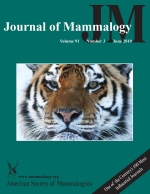The relative importance of factors that influence the habitats that animals select often varies with spatial scale. We evaluated the hypotheses that habitat selection by 2 sympatric slender opossums (Marmosops) is scale-dependent, and that coexistence in the gray slender opossum (Marmosops incanus) and the Brazilian slender opossum (M. paulensis) is enabled through differential use of habitat components or segregation in the use of vertical strata, or both. At a mesohabitat scale both species selected areas with dense understory, especially vertical obstruction 0–0.5 m above the ground. At a finer, microhabitat scale M. incanus preferred places with higher plant cover and vertical obstruction 0.5–1.0 m above the ground, and M. paulensis showed no evident pattern of selection. This result supports the hypothesis that habitat selection is scale-dependent. Although both species selected similar habitats at the mesoscale, we found segregation in the use of vertical strata, with M. paulensis being more terrestrial than M. incanus. Habitat segregation could reflect the intrinsic habitat preferences of each species or potential competition for space between the 2 congeners.
How to translate text using browser tools
16 June 2010
Multiscale habitat selection by slender opossums (Marmosops spp.) in the Atlantic forest of Brazil
Natália O. Leiner,
Christopher R. Dickman,
Wesley R. Silva
ACCESS THE FULL ARTICLE

Journal of Mammalogy
Vol. 91 • No. 3
June 2010
Vol. 91 • No. 3
June 2010
Didelphidae
habitat selection
Marmosops
mesohabitat
microhabitat
scales
vertical partitioning




